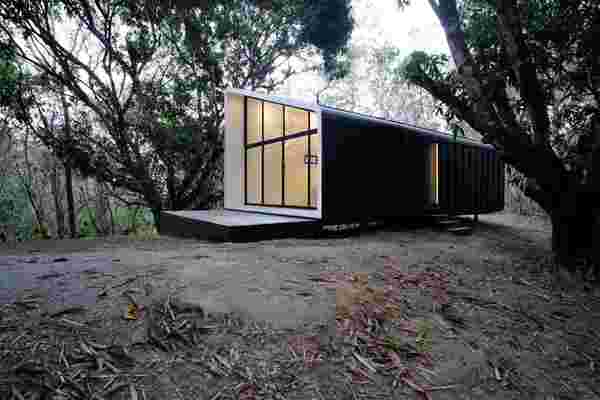{"type":"video","version":"1.0","provider_name":"Vimeo","provider_url":"https://vimeoom/","title":"#WeThePlanet Campus","author_name":"3deluxe","author_url":"https://vimeoom/3deluxe","is_plus":"1","account_type":"plus","html":"<iframe src="https://player.vimeoom/video/485074120?h=43763c7def&dnt=1&app_id=122963" width="1050" height="591" frameborder="0" allow="autoplay; fullscreen; picture-in-picture" allowfullscreen title="#WeThePlanet Campus"></iframe>","width":"1050","height":"591","duration":"229","description":"3deluxe's was commissioned by New York-based organization #WeThePlanet (WTP) to create an inspirational structure that nurtures and investigates new and forward-looking opportunities for people-friendly architecture in harmony with nature nThe #WeThePlanet Campus serves as a communicative platform to protect all life on land and under the sea while advancing the frontiers of design. The Campus offers facilities for convening international summits, workshops and educational programs which focus on transforming our world for a better future and will be addressing topics such as human longevity and planetary flourishing, climate change, social justice and equal opportunities. The floating building complex is aimed at serving as an inspiring example for future life, communicative living and working environments.","thumbnail_url":"https://i.vimeocdnom/video/1007543716-c116994c5f9d50e3699050fe18afab1bdb0ff3a7b1cc23c4cf9b7e8715a226e7-d_960","thumbnail_width":"960","thumbnail_height":"540","thumbnail_url_with_play_button":"https://i.vimeocdnom/filter/overlay?src0=https%3A%2F%2Fi.vimeocdnom%2Fvideo%2F1007543716-c116994c5f9d50e3699050fe18afab1bdb0ff3a7b1cc23c4cf9b7e8715a226e7-d_960&src1=http%3A%2F%2Ff.vimeocdnom%2Fp%2Fimages%2Fcrawler_play.png","upload_date":"2020-11-29 08:22:47","video_id":"485074120","uri":"/videos/485074120","arve_cachetime":"2021-09-27 04:40:54","arve_url":"https://vimeoom/485074120"}
Manhattan is an island but also one of the world’s most popular cities. The land area is not large enough to support all the people who move there or have facilities for multiple recreational activities. Keeping in mind that the population and our needs continue to increase but the land doesn’t, 3deluxe designed We The Planet Campus (WTP) – a mobile, floating green platform off the Manhattan shoreline for convening international summits, workshops, and educational programs which focus on transforming our world for a better future!
The fluid, organic form of the island was inspired by the natural elements surrounding it -water, sun, and wind, meanwhile, the biotope is also designed to give back as much as it takes from nature by generating its own energy and drinking water. The floating campus was commissioned by the New York-based organization ‘We The Planet’ (WTP). The campus is meant to be a communicative platform that facilitates the work for protecting all life on land and under the sea. It will host international conventions, global summits, workshops, and educational programs that focus on co-existing sustainably and preserving our planet. WTP’s vision for the campus is to make it 100% self-sufficient in generating energy and drinking water while floating marshland biotopes make up 50% of the overall surface areas.
WTP’s campus is an inspiring architectural creation that nurtures and encourages those working towards building more people-friendly structures that live in harmony with their surroundings instead of the current parasitic nature of the situation. There will be a new generation of corporate buildings that offer more than the functional shell of a building by taking a stance on relevant social issues such as climate protection and nature conservation by actually providing space for those who are working towards solving these problems. “After the shock of the pandemic and the social polarization of recent years, there is a longing for positive change. It is time for architecture and urbanism to take a more ambitious approach to humanize our living environment,” says Dieter Brell, Creative Director of 3deluxe.
The campus sits on a floating platform that is scalable, mobile, and protected from rising sea levels. Its floating natural biotope provides greenery and organically extends the tightly packed land area of the city. The partly public platform not only represents an additional destination for New Yorkers for sports, leisure, and communication but also an attractive new honeypot for western Manhattan. The campus also includes a meadow, a sand biotope, and the thatched green roofs which create living environments for a diversified, urban animal and plant world apart from the marshland biotape. The construction materials include wood, clay, reeds, and recycled materials such as bioplastics.
WTP’s ambitious campus also plans to use latest surface technologies for air cleansing along with algae bioreactors, wind farms, photovoltaics, and marine power plants that will be located under the floating platform for energy extraction. We The Planet Campus wants to be a symbol of change in future architecture as it stands on the belief that buildings should give back as much as they take – this means compensation for soil sealing, CO2 production, the use of energy and materials, while creating fair living environments for the animals and plants who were there long before us.
Designer: 3deluxe
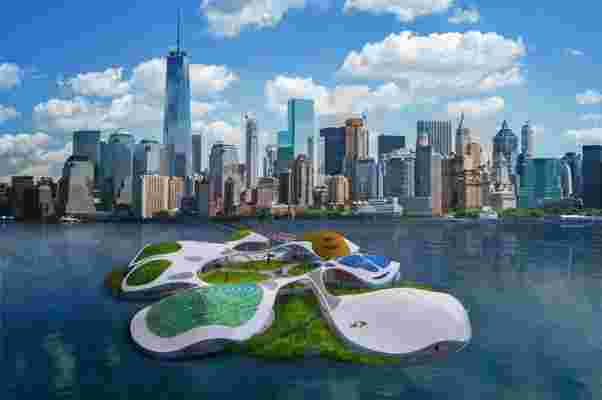
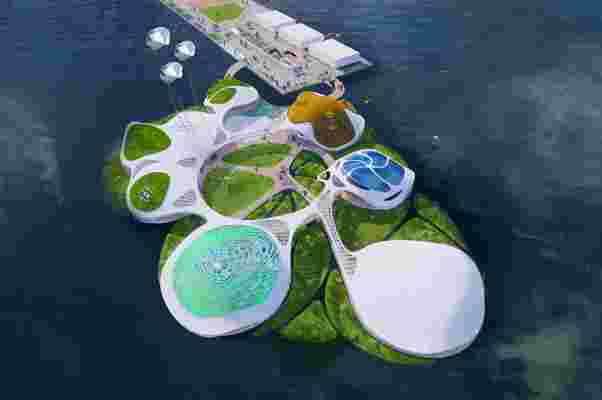
Architectural Renders that showcase a surreal future where nature rules our modern homes!
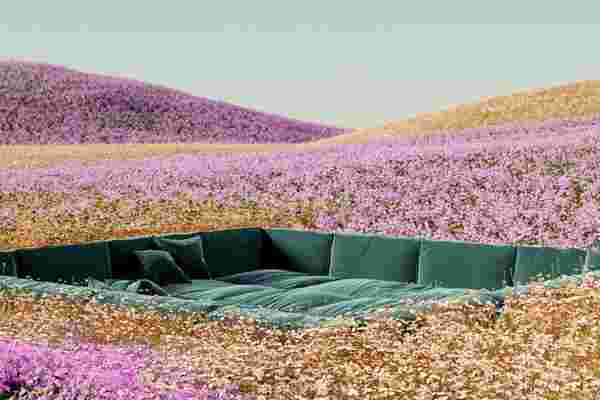
We all know how beautiful nature is – we continuously draw inspiration from it and set up space outside our homes for things to grow in an organized manner. But what if nature decided to overrun our boundaries and step into our homes? It sounds scary, but the result imagined by designer Alexis Christodoulou ( @teaaalexis ) is strikingly beautiful! Alexis imagines a world where humans have taken a step back (maybe the quarantine is still ongoing there!) and let the flowers, grass, and all the other myriad plants enter our home. Surreal but beautiful, the untouched nature tells a story of peace and harmony in each of these landscapes!
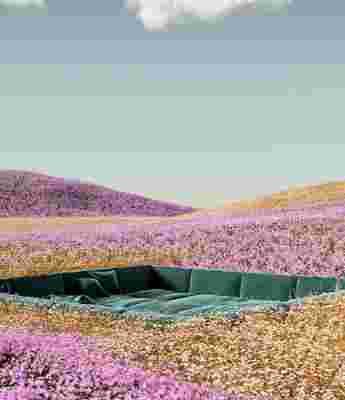
We all love a sunken seating arrangement, but Alexis elevates that situation to a whole new level. Replacing a modern living room with a field of flowers, Alexis brings the escapism to your living room.
A minimal, pristine white corridor that replaces the traditional accent rugs with something even more traditional – a carpet of flowers with a pathway running through it! Let nature come in and rule our creations to make them even better.
Autumn flows through this balcony with hues of red to yellow flourishing in there! Just looking at this render showcases the warmth of this season. If only we could smell the earthiness in the air, we would be transported to that space.
Corals come out from under the sea to meet the land in this Greece-inspired render. Now just imagine sitting on that chair and watching the sunset, it would be one of the most beautiful sunsets ever!
Green is scientifically known to cool our eyes and calm us down. It is that feeling of calm that washes over you when you look at this wall of green outside your home instead of the boring old fence!
Titled Population 001, this place is the perfect setting for one! A setting designed to help you focus and grow, this place is all set for one individual to rule.
Usually leaving a window open invites bugs and some good old-fashioned dust. But in Alexis’s world, your bathroom gets overrun by a pink weed that makes the old white tiles look retro and fashionable.
Remember those dream sequences commonly showed in movies, where children run through a field of flowers with their hands running across the flowers…this render looks like a top view of that field, only with much cooler colors!
Greenhouses may be green (logically speaking) but this one is offset by hues of rust and bronze! Maybe this is what the greenhouse on Planet Mars looks like.
Is a pool a pool if it’s orange and not blue? I truly don’t know the answer to it but it sure looks surreal yet beautiful.
Each render by Alexis is an escape to a dreamland we want to be in, situated in a space overrun by nature, away from all the clutter mankind imposes on the planet and until that happens, we can count on more designs by Alexis to keep us going!
This modular cabin uses industrial zinc to help Costa Rica meet its Carbon Neutral by 2021 pledge!
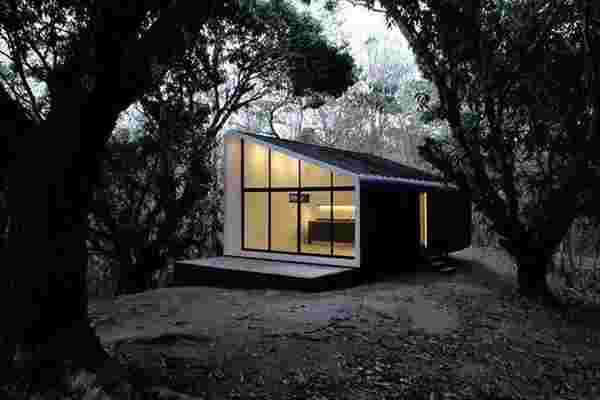
Costa Rica is widely celebrated as one of the most environmentally progressive countries in the world, pledging in 2015 to become a carbon-neutral country by 2021. Naturally, in order to uphold that pledge, Úbáli Tropical Living, a Costa Rican architecture firm committed to sustainable hotel tourism, designs eco-friendly modular cabins for various terrains that have been conceived and constructed in order to decrease carbon footprints typically caused by tourism.
Úbáli, which means chameleon in Bribri, designed their first modular cabin, called Kabëk, specifically to befit mountain living. The first model for the Úbáli Tropical Living’s eco-tourism initiative dons an inclined roof, which allows the modular house to tuck right into mountainous terrains and offers travelers the chance to fully immerse themselves and their stays in the quiet of the wood. The modular cabin has a simple design layout of four walls that enclose a bedroom, living room, kitchen, bathroom, and dining room. The construction process also promotes frugality in regard to both time and money in that its modularity and simple layout caters to the prospect of easy and relatively affordable replication. Prepared for the most extreme of climates, Kabëk is assembled using industrial zinc, an extremely durable material that reforms nicks and blemishes thanks to its own hydroxyl carbonate protective layer. Additionally, industrial zinc’s levels of low toxicity are ideal for modular homes situated in natural settings. Industrial zinc is recyclable, durable, and an eco-conscious option for roofs. For example, rainwater that flows off Kabëk’s roof does not collect any hazardous waste on its way to the ground’s soil. Kabëk’s transportability is inherently green as the construction process preserves the natural settings on which Kabëk is situated. Furthermore, the materials used to build the modular home – industrial zinc, gypsum, and Densglass – form an ecologically sound structure that can withstand irregular changes in weather.
Once buyers attain land and construction permits, the building process takes just about two months to reach completion. In addition to the environmentally sustainable qualities and money-conscious design concept, Kabëk comes with installed septic tanks and the properly outfitted facilities needed for longer stays. The home is equipped with essential lifestyle products and tools in order to maintain convenience for a trip that otherwise brings you one on one with the mountain’s bare, albeit restorative, necessities.
Designers: Pablo Esteban Valle and Arthur Micheron x Úbáli Tropical Living
